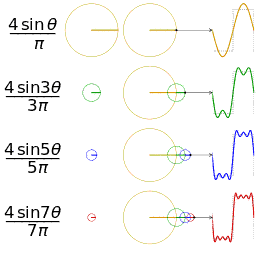
The real magical gotcha of frequency domain analysis is that any function can be represented as an infinite sum of sine waves. That means that whatever signal you have in the left frame, you can get an arbitrarily close approximation of it by summing enough sinus signals. For example, if we want to get a square wave:

If you zoom in on the corners of a square wave on a good oscilloscope, you will see this effect. This is because your signal passes through components that cannot support infinitely high frequencies, so that a square wave cannot be perfectly represented.
Simply put, frequency analysis represents a signal as the magnitudes of the sine waves required to "build" it.